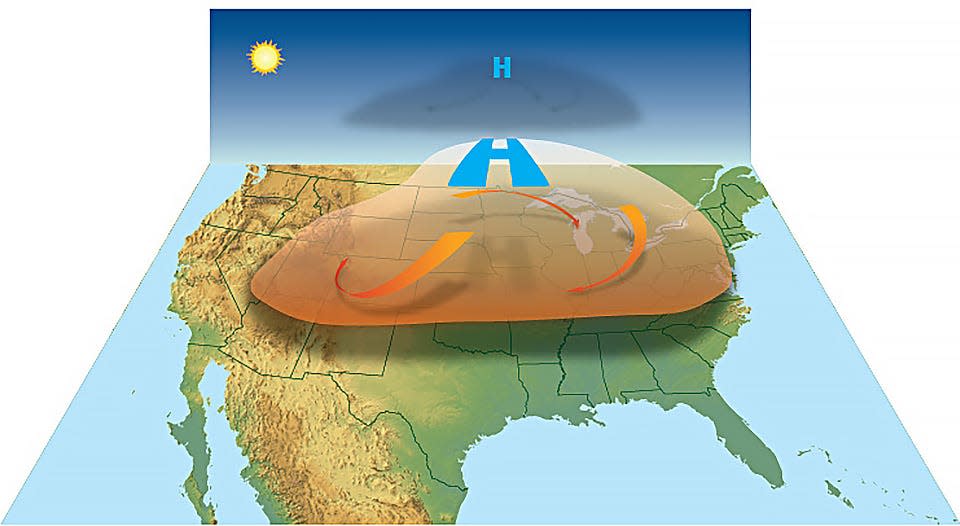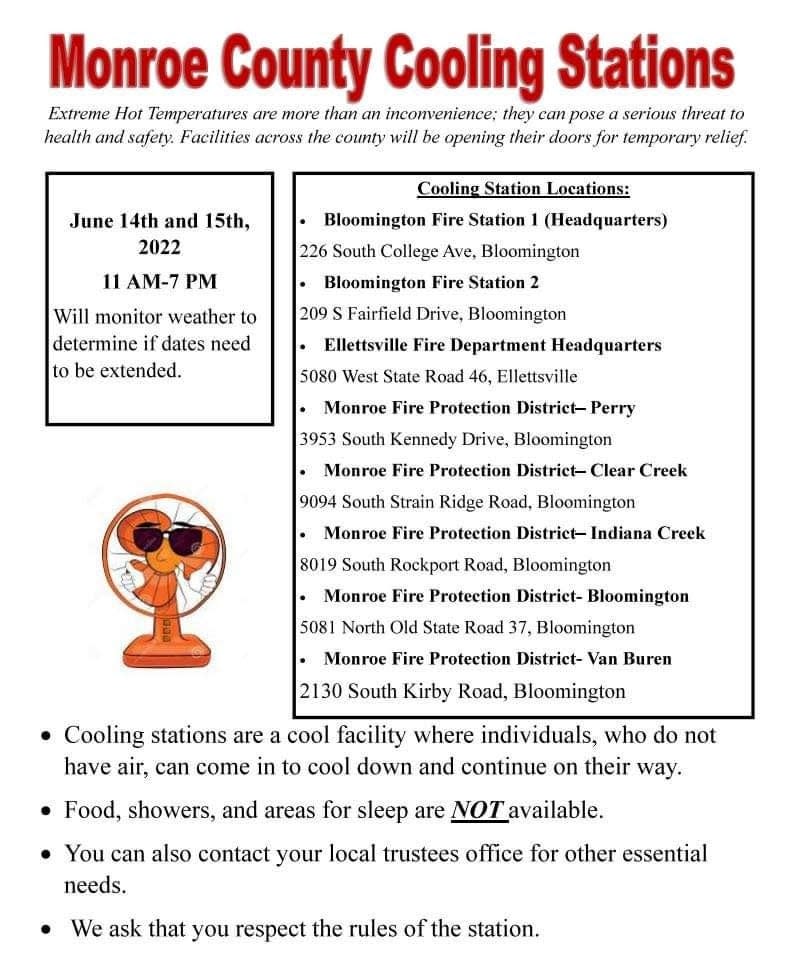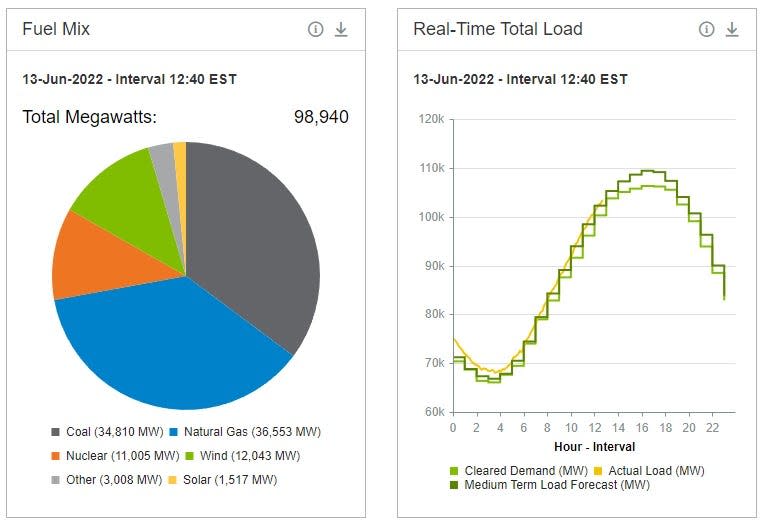'Heat dome' to trap Indiana residents in record heat; utility warns of possible blackouts

A "big heat dome" is building above much of Indiana and will trap Hoosiers in temperatures they have not seen this early in the year in more than a century.
At least one regional utility warned “extremely high” demand for electricity will raise “the possibility of rolling blackouts" though they remained "very unlikely." Nonetheless, the utility urged customers to curb their electric usage during peak hours, between 2 and 8 p.m.
More: Indiana may experience rolling blackouts this summer. What are they?
Temperatures in Bloomington are forecast to rise to 97 degrees Tuesday, but the National Weather Service warned humidity will push heat indexes to 109 degrees. Next week’s temperatures are projected to rise as high as 99 degrees.
The same high pressure ridge that has produced record heat across much of the western part of the country has now reached Indiana and is building a "heat dome” right above much of the Hoosier state, said Cody Moore, meteorologist with the NWS in Indianapolis.
The high pressure comes with sinking air and pulls a lot of warm air from the south to create very hot conditions, he said.
Such weather patterns typically happen in mid-to-late summer and are “pretty rare” this early in the year, Moore said.
He said he expects the heat dome to produce temperatures this week that will exceed records for Indianapolis that were set in 1913.
“We are forecasting record highs for much of central Indiana for the week,” he said.
He urged Hoosiers to stay safe by drinking lots of water and limiting outdoor activities. If people have to go outside, he said they should do so early or late in the day and wear sunscreen and light-colored clothing.
Your Health: Extreme temperatures are here. Water is the best way to fight dehydration
You can find other tips on how to keep people pets safe at tinyurl.com/mr37z4ms.
'Now is the time' to conserve
Utilities District of Western Indiana REMC, which includes 16,000 customers in 10 Indiana counties including Greene, Lawrence and Monroe, said Monday that extremely high energy demand this week prompted it to alert customers of the possibility of rolling blackouts in the coverage area.
“I think they are very unlikely, but they are not impossible,” the cooperative’s CEO, Doug Childs, said Monday.
The cooperative based its assessment on a “capacity alert warning” issued by the Midcontinent Independent System Operator, a nonprofit member-based organization responsible for the power grid across 15 states.
Based on current forecasts, the MISO region will get within 3.5% of maximum capacity Wednesday afternoon, Childs said.
“This is definitely the tightest I’ve seen it,” Childs said. “Every operator is scared to death when it gets that low.”
He urged customers to reduce their power consumption to ease strain on the power grid.
“Anything people can do to conserve, now is the time to do it,” he said.

The utility urged customers to curb their electric usage especially during peak hours, between 2 and 8 p.m. by, for example, not running dishwashers or clothes dryers during that period and by setting their thermostats a few degrees higher than normal.
While MISO has about 10 steps in place to avoid blackouts, Childs said the severity of the problem can escalate quickly if multiple power plants go offline or the transmission system suffers a significant interruption.
On the off chance the utility has to implement rolling blackouts, Childs said the cooperative plans to have 30-minute blackouts followed by at least 90 minutes of restored service. He said the utility plans to exclude from any blackouts critical infrastructure such as first responders, health care providers and the Monroe County Airport.
As of 12:35 p.m. Monday, MISO said on its website that its region was producing a total of about 99,000 megawatts of power, while demand at that time exceeded 103,000 megawatts. Power plants fired with coal and natural gas each were providing about a third of the capacity. Wind and nuclear each added about 10%.

MISO said it issued a “capacity advisory” and a “conservative operations” declaration for this week, but a representative could not be reached Monday say what those terms mean. On its website, the nonprofit lists emergency procedures that can “provide operators with additional resources not available under normal grid conditions.” Those procedures include accessing reserve generation, reducing power usage and importing emergency power.
Rolling blackouts a 'last resort'
A spokeswoman for Duke Energy, which has 54,000 customers in Monroe County, said rolling blackouts are a “last resort."
“We have never had to do that on our Indiana system,” said Angeline Protogere, Duke’s principal communication consultant.
Protogere said Duke has arrangements in place to increase supply and/or lower demand if necessary. She said the utility can:
Buy electricity from other providers, though how much a utility can purchase depends on market conditions.
Fire up so-called peaking plants, which are typically gas-fired and can be started quickly in periods of high demand.
Ask large industrial power users to reduce their demand by curbing operations. The reductions are voluntary and part of agreements the utility reaches primarily with industrial customers. Those customers gain a financial benefit, such as a lower rate, in exchange for a reduction in demand.
However, Protogere also said Duke is part of the MISO grid, which means even if an individual member has adequate supply for its customers, it may be affected by shortfalls across the entire region.
MISO previously has said it lost about 2% of its power generation capacity in the last year in part because fossil-fueled plants were retired to make way for cleaner energy sources. Also, a key transmission line was shut down for maintenance after tornado damage.
Another Bloomington area electric provider, South Central Indiana REMC, said via email that it "could be ordered to reduce load and implement rolling blackouts if the energy supply/demand problem becomes too great" though it said it would "continue to do everything we can to minimize the impact on our members."
"We are asking that members reduce electricity consumption during extreme temperatures when demand is high. Simple steps like turning off lights, unplugging small appliances when not in use and adjusting thermostats a little higher can make an impact," the cooperative said.
SCI REMC said it will share information through its Facebook page and website.
Moore, the meteorologist, said the early heat wave does not portend an unusually hot summer. The NWS predicts a 50/50 chance of above normal temperatures in the next month and a slightly higher than average chance of above-normal temperatures in the next three months.
Boris Ladwig is the city government reporter for The Herald-Times. Contact him at bladwig@heraldt.com.
This article originally appeared on The Herald-Times: Excessive heat in Indiana could last 2 weeks, straining power grid

